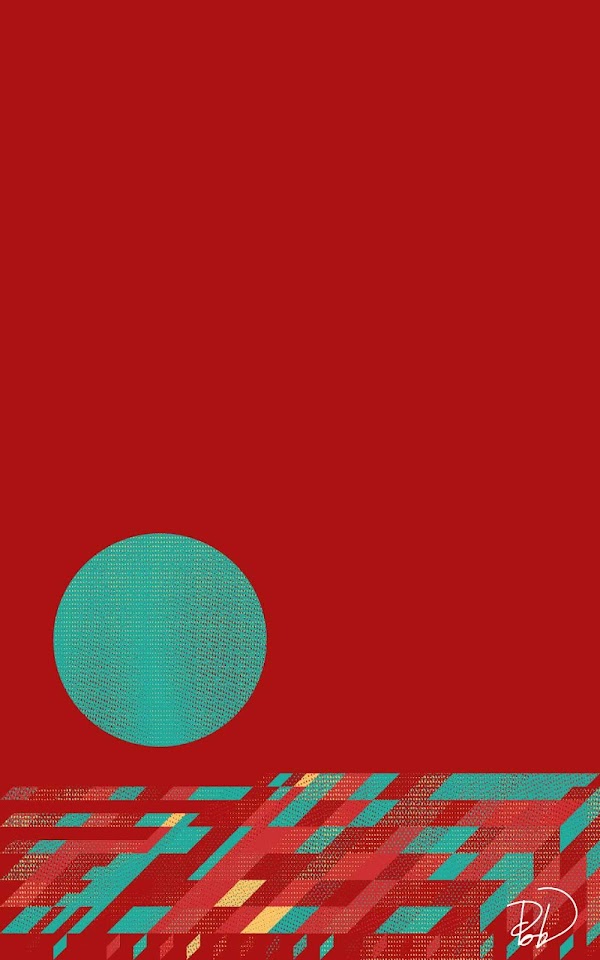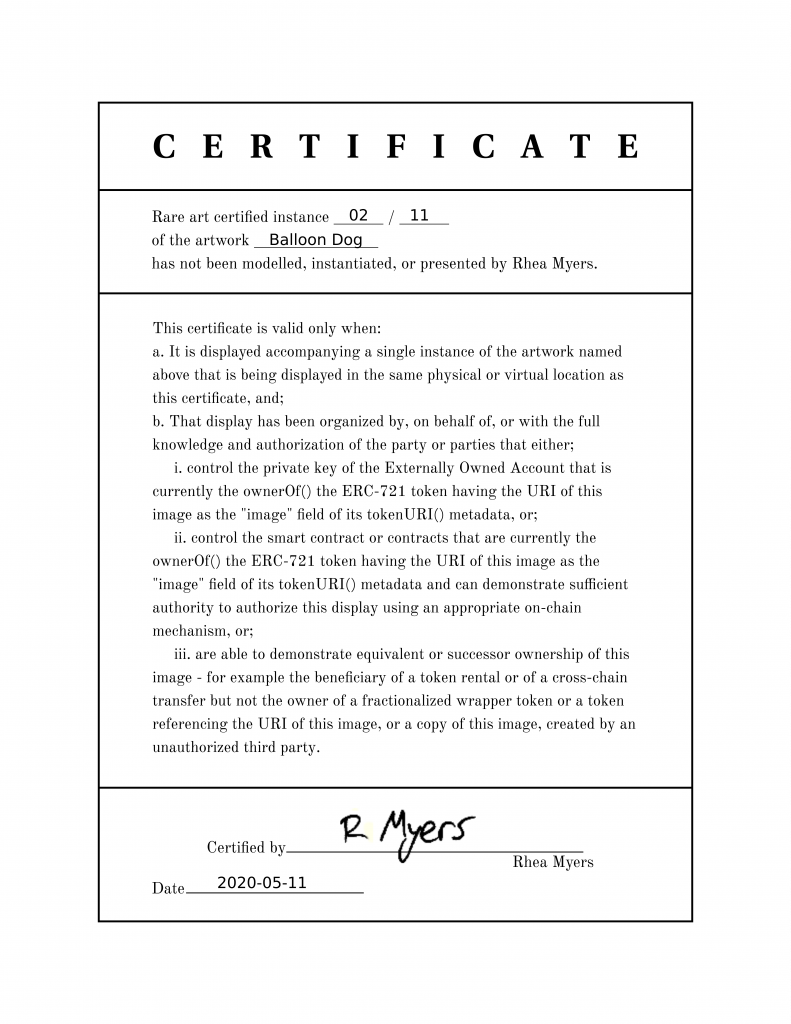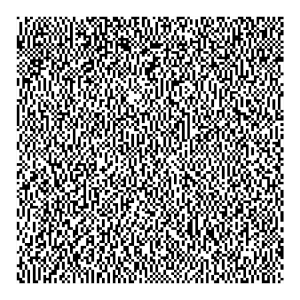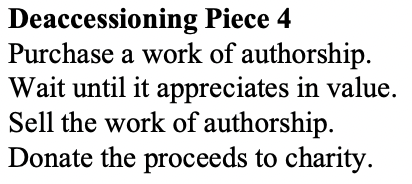The Church of Subway Jesus Pamphlets
Steve Pikleny built a church in the metaverse Voxels to showcase his collection of real-world religious ephemera.

As a member of the Toronto-based art collective Studio F Minus, Mitchell Chan has designed a dress that moves in response to the frequencies sung by its wearer, made a sequin-upholstered tunnel that became a viral Instagram hit, and shot babies out of a cannon (not real babies). But he’s best known as the creator of Digital Zones of Immaterial Pictorial Sensibility. The 2017 project explored the abstraction of value and ownership by grafting Ethereum token protocols onto the concept of Yves Klein’s Zones of Immaterial Pictorial Sensibility (1962), for which the artist traded receipts of ownership of empty space in a gallery for gold ingots, then burned the receipts and tossed the gold in the Seine, so that nothing remained of the transaction but a record in a ledger. When first exhibited, the Digital Zones seemed too esoteric to attract much attention. But they were rediscovered during the NFT market boom early this year, and Chan found himself at the center of the conversation and part of a new community. His IKB tokens, re-released on the current standard, were sought after by collectors, and he became a collector himself, buying and trading works by his peers. Here Chan walks us through the highlights of his collection, explaining how they cover a variety of conceptual approaches to art on the blockchain and what they mean to him personally.

My only motivation for getting into crypto was trying to find an art material. It was 2017 and I was on a trajectory of creating increasingly materially minimal work. The exhibition I’d done in 2016 had a sculpture made of clouds and water vapor. That’s about as light as a material you can use that is still physical. But unlike minimalists of the past who pursued reduction to deny the possibility of the artwork containing any representation, I believed that the use of an ethereal material palette was the best way to represent important things. Our world is informed by systems and structures that have a big impact on our lives but are nonetheless invisible. So the best way to make art about it is to use materials that are just on the cusp of invisibility. I wanted to do was a project about economic systems and ownership. I learned there was this programmable money called Ethereum, and that’s how I came into crypto.

It is to my great discredit that I was not aware of Rhea Myers’s work when I started mine, because she’d been at it for years. But she was coming at it from the perspective of finding parallels of the values and ideas that were in blockchain and those of the artists she was interested in, like Lawrence Weiner and the Art & Language movement. It’s really telling that these connections to art history were there right from the beginning—Rhea was designing artworks for Ethereum when it was still in a testnet. She realized that conceptual art is a really good tool for understanding this technology that dematerializes ownership, that reduces ownership to a verifiable idea.
I finished my project in 2017. No one really cared about it. Then I came back and I had a lot of catching up to do—I learned about Rhea’s work, and I felt an incredible sense of delight and excitement and energy and validation. It was always a goal of mine to get a piece of Rhea’s because I consider her to be the most important artist in this field. I ended up getting Certificate of Inauthenticity (2020), which was the first ERC-721 token artwork that she made. The objects that her certificate is authenticating—or rather, not authenticating—are files you can print out on a 3D printer: a balloon dog, a pipe, a urinal. They all represent works by artists—Koons, Magritte, Duchamp—who have shunned the concept of the artist’s hand, who insisted that their authorship was valid because they claimed it. Artists have long been able to claim authorship over an artwork that they have never touched. Myers’s work cheekily refutes that status quo by certifying that she is not the author of these artworks that were fabricated without her hand. Instead, the artwork points out that blockchain enables people to claim ownership over an artwork that they have never touched.

Jonathan Chomko is someone I discovered early this year. We met on Discord and then realized we live in the same city. Jonathan is another artist who was thinking about labor early on. In Proof of Work he set up a program where he has to push a key at regular intervals to produce a pixel. The closer he comes to hitting the key at the precise tick of the metronome, the closer the pixel will be a certain color. Say it’s supposed to be computer blue. If he’s off by a fraction of a second, it will be a slightly different shade of blue. He’s reducing himself to a servile mechanism, to comment on the incessant monotony of how computers work. What comes out is inherently flawed, because he can’t be a perfect metronome, [but he’s trying a version of the computer that through brute strength produces a crypto hash or an image filter. I like how he’s injecting humanity into the monotonous world of computing. And he does something that I believe is essential in conceptual art: when you’re trying to point out the absurdity of something, make sure that you as the artist are the butt of the joke. He had to sit at the computer for a full day! Just going click–click–click.

Brian Frye is someone whose work I just recently got into. His “Conceptual Art Pieces” and “Deaccessioning Pieces” are like what you’d find in Yoko Ono’s Grapefruit book. I have one that says “Create a work of conceptual art. Offer to sell it to anyone who wants it. Argue that selling it is illegal.” There’s a lot of work out there that represents the technological framework for NFTs. Jonathan embodies the monotony of blockchain, Rhea’s Secret Artwork gives form to cryptography. But Brian is representing and giving shape to the legal layer. This is going to become a major thing we have to think about. Brian is a legal scholar who is already doing that, in very creative and unconventional ways.

My token from Sarah Friend is an all-black image in the same resolution as the display of an iPhone 7 Plus. I’m excited to have a work by her because she’s another Canadian OG—I have a hometown bias in my collection, I won’t even try to hide it. And I’m excited by this piece because I don’t know what it is yet. It’s part of Off, a social game that involves connecting on email or Telegram. Apparently the real content of this piece is hidden and there’s some sort of puzzle that all the holders of tokens need to come together and share information in order to solve. I talked about work that represents the technological layer and legal layer; Sarah is playing with the social layer. To create an artwork that builds a community of people who come together to unlock meaning and value—that’s a pretty good representation of the NFT space.
Fast Food IKB is the pride of my career. I made Digital Zones in 2017, and earlier this year I made a wrapper for them so they could be on OpenSea. That project is boring. It demands that you read a 33-page white paper to get it. To my surprise, people actually read it. I’m completely flattered. The thing I’ve come to love about NFT culture is that everything will eventually be reduced to a meme. The fast food meme has appeared for a couple of projects. Fast Food Punks is a thousand Cryptopunks wearing McDonald’s hats. There’s a kind of nihilistic sensibility to it—this idea that the market will crash and we’re all going to end up working at McDonald’s. When someone put the McDonald’s cap on the receipts for Digital Zones, I thought: “That’s it! I made it.” I can’t ask for something more flattering than being memed. And I love that it’s just a conceptual art project with a hat on. I have another NFT that commemorates Digital Zones in a very different way. Proof of Beauty is a collective that mints tokens from transactions on the Ethereum network and assigns each one to a piece of on-chain generative art. I took the hash where the first-ever IKB token was burned. I like the way they form a personal connection with the token.
DEAFBEEF is an artist who is not trying to aestheticize the blockchain or making a comment on it through art but actually using it as a medium. It’s a really difficult medium to use, because Ethereum is so limited. But DEAFBEEF has a background in computer science and music and just got it right away. He realized he could make these minimal monochromatic animations with sound. But the main reason I got it was personal. I swapped with him. The piece I got from Rhea was a swap, too, and those are the most meaningful acquisitions I can make. I don’t care about market value. I’m going to keep them forever. To swap with another artist who you really respect and admire validates you in a way that no market can. DEAFBEEF is someone I’ve been able to meet up with a few times. We both live in Toronto, we’re the same age, we both have two kids, and we’ve both had the same crazy year in terms of markets and attention. I feel extremely fortunate, but it’s important to stay level-headed amid all this insanity. So it’s great to be able to connect with someone in my own town. I value him as a person, so that piece means a lot to me. I see collecting as a way to build a community. People roll their eyes at that word, but it is nice! All the artists I’ve mentioned are people I’ve talked to quite a bit. This level of interaction with my peers was not something that I got in all my years of working with galleries and doing public art. That’s really meaningful to me. So my collection is really about having mementos connected to this very special time in my life. It has been crazy. Who knows what is going to happen next? But even if it all goes away tomorrow, I will always look at these things in my wallet and say: “That was a hell of a time, those were cool people, those were great relationships.” It’s incredible that a digital token can be a token of something so emotional and meaningful.
—As told to Brian Droitcour
